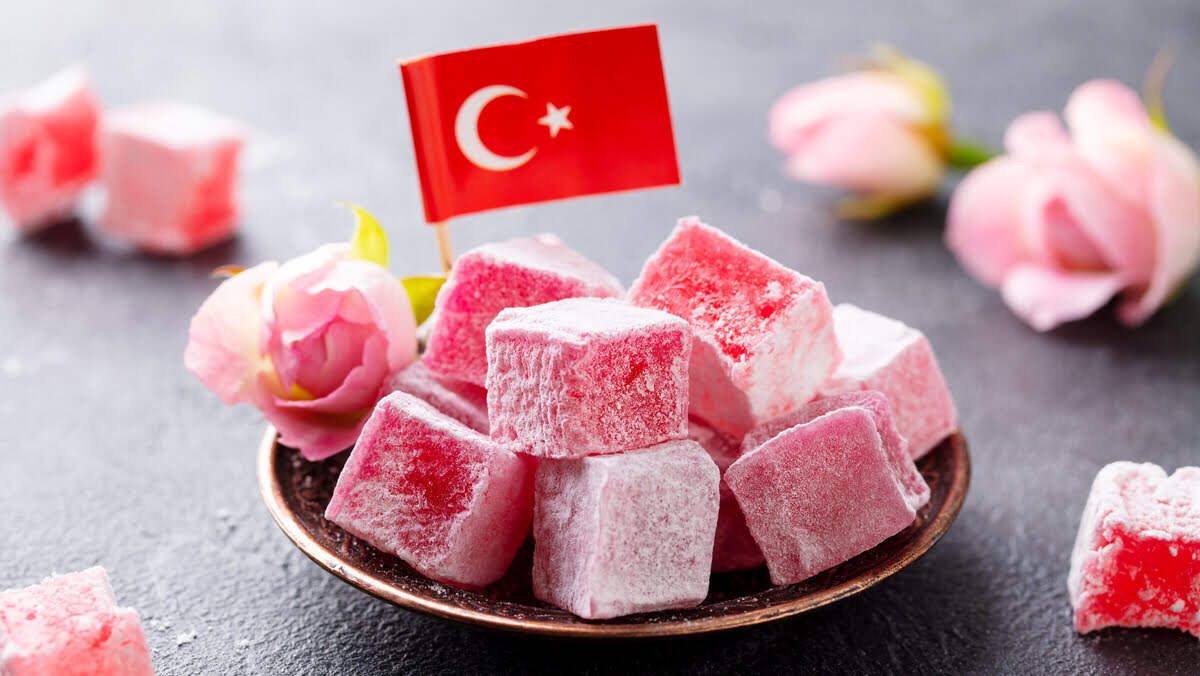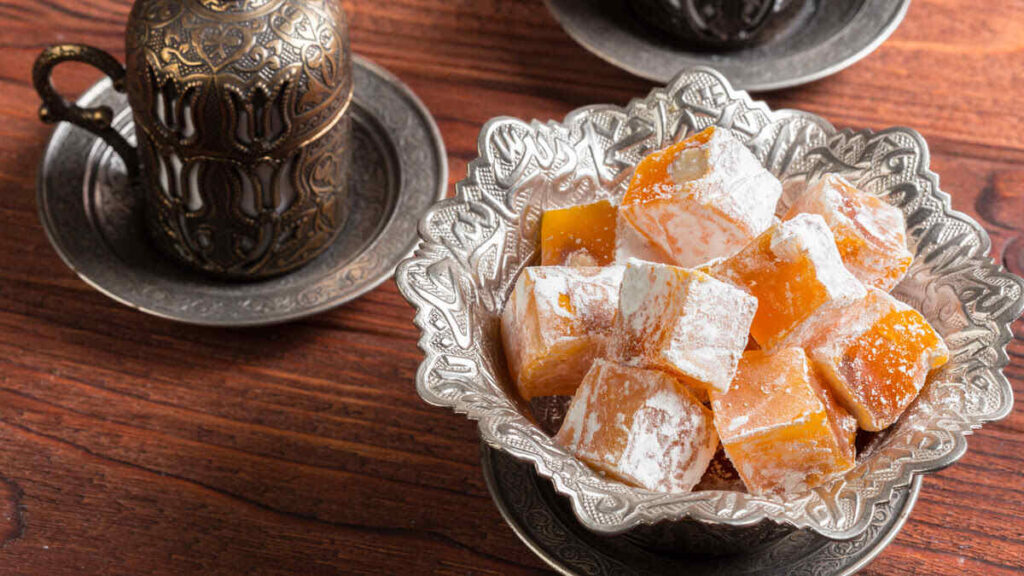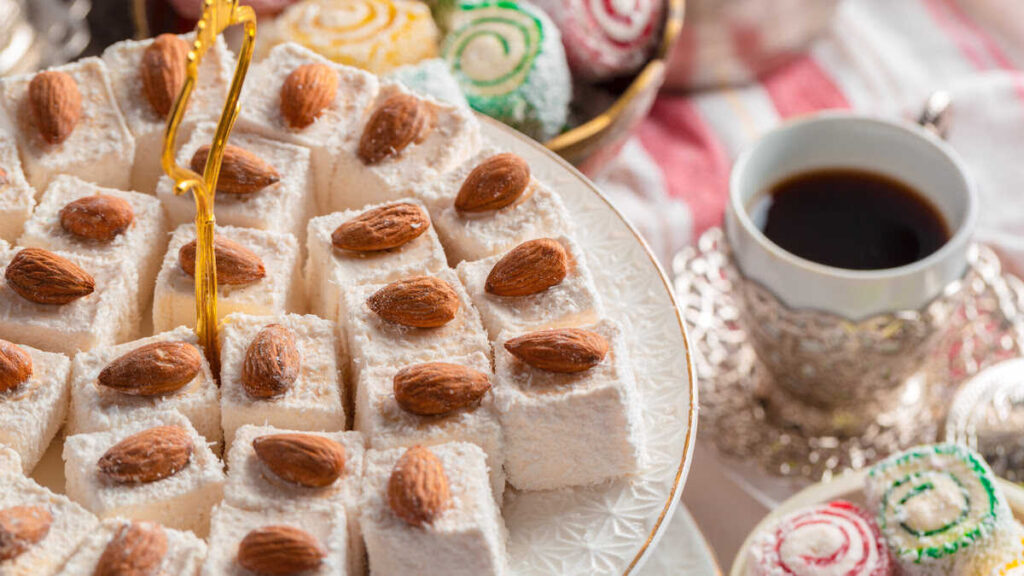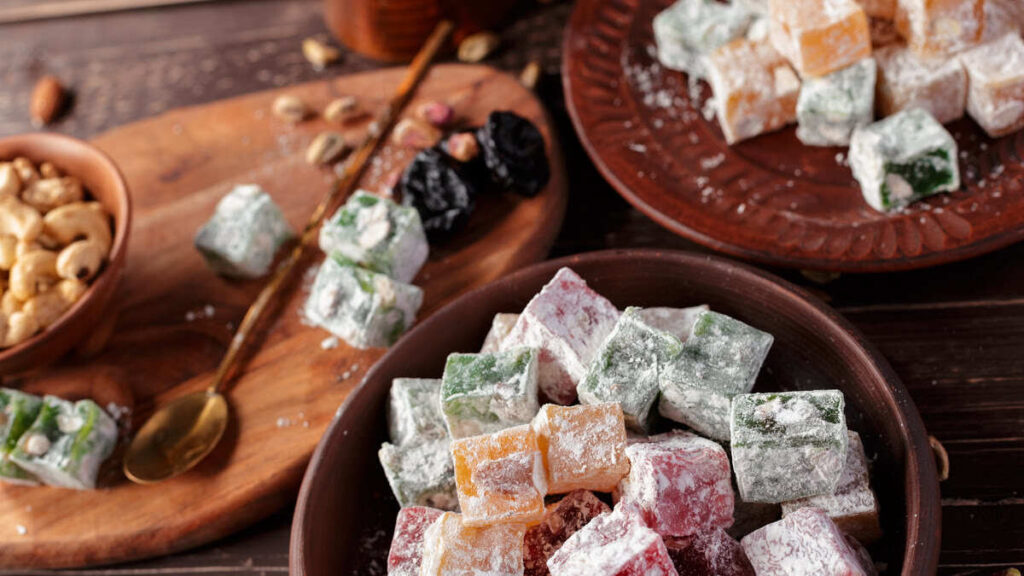
Turkish Delight – A Sweet Icon of Ottoman Cuisine

Turkish delight, also known as lokum or rahat-ul hulkum, is one of the most iconic traditional sweets originating from Turkish culinary heritage. These small, soft, jelly-like cubes captivate with a wealth of flavours and aromas – from the classic rose water to nut-filled varieties and exotic fruit undertones.
Sprinkled with powdered sugar or shredded coconut, Turkish delight has been delighting sweet lovers around the world for centuries, becoming a symbol of Turkish confectionery artistry. Its history, dating back to the Ottoman Empire, holds many fascinating stories worth discovering.
What is Turkish Delight?
Turkish delight, known also as lokum, is a true hallmark of Turkish cuisine. It’s almost unthinkable to visit Turkey without encountering this colourful sweet treat, available in nearly every local store.
Present in Turkish tradition since the 15th century, lokum is a type of soft jelly made from sugar and starch, enriched with natural aromas and colourings like rose water, lemon or pomegranate juice.
The Arabic-derived name rahat-ul hulkum literally means “relief for the throat”, which perfectly reflects the dessert’s smooth, silky texture. In the past, Turkish delight was enjoyed not only in the Ottoman Empire but also in countries like Poland, Hungary and Austria, where it was known as “Turkish bread”. Interestingly, Turkish delight made a notable appearance in literature – in The Chronicles of Narnia, it was the treat used by the White Witch to enchant Edmund.
Today, Turkish delight continues to enchant with a huge variety of flavours and additions. Some regional types, like the kaymak-filled version from Afyon, are considered true culinary treasures.
The History of Turkish Delight
The origins of Turkish delight trace back to the grandeur of the Ottoman Empire, although the exact story behind its creation remains uncertain. Lokum is regarded as one of the oldest desserts in the world, celebrated not just for its refined flavour but also for its unique texture – a staple of Turkish food culture.

The Legend of Sultan Abdul Hamid I
One popular tale links the birth of lokum to Sultan Abdul Hamid I. According to the legend, although not a famous strategist, he deeply valued the role of pleasure in building relationships. To please his many wives and concubines, he instructed his royal confectioners to create a dessert that would bring them both comfort and joy. They responded with a soft, chewy sweet made from starch and sugar syrup, filled with nuts and dried fruits. Its taste was so exceptional that it quickly became a fixture at palace banquets, bringing harmony to the harem.
Bekir Effendi – The Confectioner Who Won Over Istanbul
Another version credits the invention to Bekir Effendi, a master confectioner from the mountainous region of Kastamonu. In 1776, he arrived in Istanbul and opened a small sweet shop. His creativity and refined sense of taste led to the creation of a unique Turkish delight that quickly captured the hearts of locals and attracted the attention of the sultan’s court. Interestingly, Turkish delight wrapped in lace handkerchiefs became a popular gift between lovers – a symbol of affection.
The Flourishing of a Family Legacy
After Bekir Effendi’s death, his son Mehmet Muhiddin continued the tradition and brought Turkish delight to international fame, winning many confectionery awards. The following generation, led by Ali Muhiddin, transformed the family business into a sweet empire, opening stores not just in Turkey but also in Egypt. The Ali Muhiddin Hacı Bekir brand still exists today, and their historic shop near the New Mosque in Istanbul continues to attract tourists and traditional sweet lovers.
How is Turkish Delight Made?
The process of making Turkish delight involves simple, natural ingredients, but demands great precision, temperature control, and patience.
The base of this classic sweet is a mixture of starch – usually potato or corn – and sugar. These are carefully combined and simmered for a long time over low heat until the mixture thickens and becomes translucent. This slow cooking results in the elastic, jelly-like texture characteristic of Turkish delight.
Various flavourings and inclusions are added to the base. Traditional recipes often include dates, pistachios, hazelnuts or walnuts. These ingredients enhance both the taste and texture. Natural aromas – like rose water, orange essence, lemon juice, peppermint oil or mild spices such as cinnamon – give each batch its distinctive character.
Once the mixture reaches the desired consistency and flavour, it is poured into flat trays to cool and set. Once firm, it is cut into small cubes and dusted with powdered sugar or coconut flakes, which prevents sticking and adds visual appeal. Thanks to its delicate, slightly chewy texture and gentle sweetness, Turkish delight pairs beautifully with strong Turkish coffee and often serves as a refined end to meals across the Middle East.
Most Popular Turkish Delight Flavours
While rose water remains the most iconic flavour of Turkish delight, there are countless variations. The richness of flavours and preparation techniques ensures that there’s something for everyone.
Among traditional options, rose water stands out for its floral aroma and subtle sweetness – often seen as the essence of lokum. Lemon, orange and mint are also popular for their refreshing notes. Spicier versions feature cinnamon, mastic (resin from the mastic tree) or even ginger.
Many regional varieties of lokum include nuts – usually pistachios, walnuts or hazelnuts – adding a pleasant crunch. In the town of Afyon, a renowned centre for Turkish delight, a famous variety includes kaymak, a thick cream made from water buffalo milk, layered between jelly and topped with shredded coconut.

Contemporary variations include more exotic ingredients such as pomegranate, mango, or passion fruit. The range of flavours and textures keeps Turkish delight relevant and appealing, not only in Turkey but around the world.
Traditional Turkish Delight Recipe
Making Turkish delight at home isn’t the easiest task, but with a bit of patience, the results can rival those found in Istanbul’s finest confectioneries. Here’s a tried-and-true recipe yielding about 30 pieces:
Ingredients:
- 800 g sugar
- 1 tablespoon lemon or lime juice
- 575 ml water
- 120 g cornflour
- ¾ teaspoon citric acid
- 300 ml blackcurrant, pomegranate, or other fruit juice
- 160 g icing sugar + extra for dusting
- 30 g cornflour for coating
Instructions:
- In a large pot, combine sugar, 375 ml water, and lemon juice. Heat gently, stirring until fully dissolved. When boiling, brush down any sugar crystals from the sides of the pot. Boil for 30 minutes until the mixture reaches ~130°C. Remove from heat.
- In a separate pan, combine 200 ml water, fruit juice, citric acid, and cornflour. Stir continuously over low heat until the mixture thickens significantly.
- Gradually stir in the hot sugar syrup into the thickened starch mixture, mixing thoroughly after each addition.
- Return to low heat and simmer for 1 hour and 20 minutes, stirring frequently to prevent burning.
- Line a 20×20 cm tray with baking paper and lightly oil it. Pour in the mixture, smooth the surface, and let it set overnight.
- Once firm, dust the top with icing sugar and cornflour. Gently remove from the paper, transfer to a dusted work surface, and cut into cubes (a pizza cutter works great).
- Coat each piece in the icing sugar and cornflour mixture to prevent sticking. Store in an airtight container at room temperature, generously dusted to keep them from clumping.
Turkish Delight in Perspective
Though often compared to jelly sweets, Turkish delight offers a truly unique texture and depth of flavour not easily found elsewhere. Notably, unlike many modern desserts, it contains no gelatin, relying instead on traditional starch-sugar chemistry – making it suitable for vegetarians and often searched as gelatine-free Turkish sweets.

With its deep history, broad flavour spectrum, and refined presentation, Turkish delight remains one of the most recognisable hallmarks of Turkish culinary culture. Whether choosing a classic rose-scented version or a tropical twist, lokum offers a delicious bridge between past and present. It’s a tradition worth embracing – whether abroad or from the comfort of your own kitchen.



